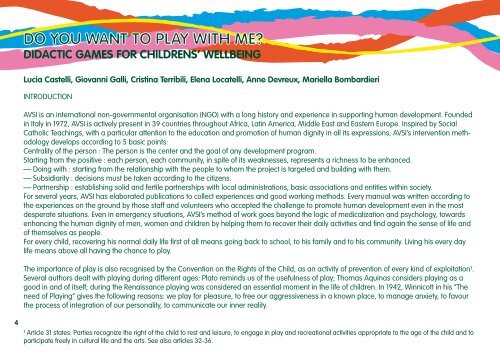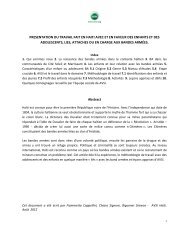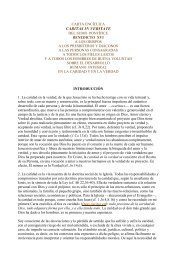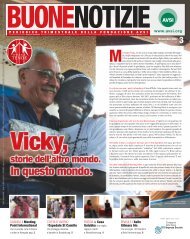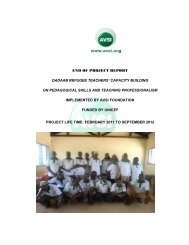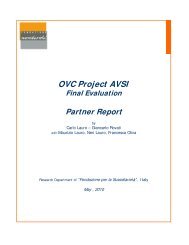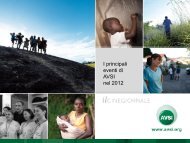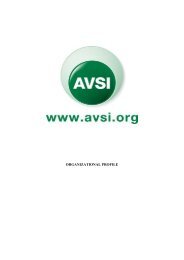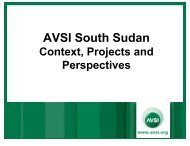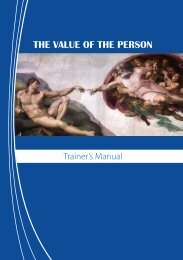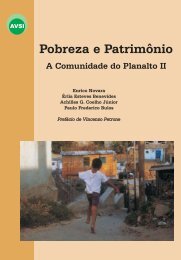Do you want to play with me: Didatic games for ... - AVSI-USA
Do you want to play with me: Didatic games for ... - AVSI-USA
Do you want to play with me: Didatic games for ... - AVSI-USA
- No tags were found...
Create successful ePaper yourself
Turn your PDF publications into a flip-book with our unique Google optimized e-Paper software.
DO YOU WANT TO PLAY WITH ME?DIDACTIC GAMES FOR CHILDRENS’ WELLBEINGLucia Castelli, Giovanni Galli, Cristina Terribili, Elena Locatelli, Anne Devreux, Mariella BombardieriINTRODUCTION<strong>AVSI</strong> is an international non-govern<strong>me</strong>ntal organisation (NGO) <strong>with</strong> a long his<strong>to</strong>ry and experience in supporting human develop<strong>me</strong>nt. Foundedin Italy in 1972, <strong>AVSI</strong> is actively present in 39 countries throughout Africa, Latin A<strong>me</strong>rica, Middle East and Eastern Europe. Inspired by SocialCatholic Teachings, <strong>with</strong> a particular attention <strong>to</strong> the education and promotion of human dignity in all its expressions, <strong>AVSI</strong>’s intervention <strong>me</strong>thodologydevelops according <strong>to</strong> 5 basic points:Centrality of the person : The person is the center and the goal of any develop<strong>me</strong>nt program.Starting from the positive : each person, each community, in spite of its weaknesses, represents a richness <strong>to</strong> be enhanced.— <strong>Do</strong>ing <strong>with</strong> : starting from the relationship <strong>with</strong> the people <strong>to</strong> whom the project is targeted and building <strong>with</strong> them.— Subsidiarity : decisions must be taken according <strong>to</strong> the citizens.— Partnership : establishing solid and fertile partnerships <strong>with</strong> local administrations, basic associations and entities <strong>with</strong>in society.For several years, <strong>AVSI</strong> has elaborated publications <strong>to</strong> collect experiences and good working <strong>me</strong>thods. Every manual was written according <strong>to</strong>the experiences on the ground by those staff and volunteers who accepted the challenge <strong>to</strong> promote human develop<strong>me</strong>nt even in the mostdesperate situations. Even in e<strong>me</strong>rgency situations, <strong>AVSI</strong>’s <strong>me</strong>thod of work goes beyond the logic of <strong>me</strong>dicalization and psychology, <strong>to</strong>wardsenhancing the human dignity of <strong>me</strong>n, wo<strong>me</strong>n and children by helping them <strong>to</strong> recover their daily activities and find again the sense of life andof themselves as people.For every child, recovering his normal daily life first of all <strong>me</strong>ans going back <strong>to</strong> school, <strong>to</strong> his family and <strong>to</strong> his community. Living his every daylife <strong>me</strong>ans above all having the chance <strong>to</strong> <strong>play</strong>.The importance of <strong>play</strong> is also recognised by the Convention on the Rights of the Child, as an activity of prevention of every kind of exploitation¹.Several authors dealt <strong>with</strong> <strong>play</strong>ing during different ages: Pla<strong>to</strong> reminds us of the usefulness of <strong>play</strong>; Thomas Aquinas considers <strong>play</strong>ing as agood in and of itself; during the Renaissance <strong>play</strong>ing was considered an essential mo<strong>me</strong>nt in the life of children. In 1942, Winnicott in his “Theneed of Playing” gives the following reasons: we <strong>play</strong> <strong>for</strong> pleasure, <strong>to</strong> free our aggressiveness in a known place, <strong>to</strong> manage anxiety, <strong>to</strong> favourthe process of integration of our personality, <strong>to</strong> communicate our inner reality.4¹ Article 31 states: Parties recognize the right of the child <strong>to</strong> rest and leisure, <strong>to</strong> engage in <strong>play</strong> and recreational activities appropriate <strong>to</strong> the age of the child and <strong>to</strong>participate freely in cultural life and the arts. See also articles 32-36.


